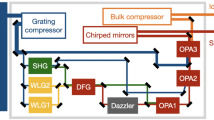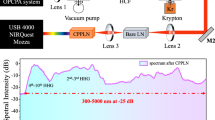Abstract
Powerful coherent light with a spectrum spanning the mid-infrared (MIR) spectral range is crucial for a number of applications in natural as well as life sciences, but so far has only been available from large-scale synchrotron sources1. Here we present a compact apparatus that generates pulses with a sub-two-cycle duration and with an average power of 0.1 W and a spectral coverage of 6.8–16.4 μm (at −30 dB). The demonstrated source combines, for the first time in this spectral region, a high power, a high repetition rate and phase coherence. The MIR pulses emerge via difference-frequency generation (DFG) driven by the nonlinearly compressed pulses of a Kerr-lens mode-locked ytterbium-doped yttrium–aluminium–garnet (Yb:YAG) thin-disc oscillator. The resultant 100 MHz MIR pulse train is hundreds to thousands of times more powerful than state-of-the-art frequency combs that emit in this range2,3,4, and offers a high dynamic range for spectroscopy in the molecular fingerprint region4,5,6,7 and an ideal prerequisite for hyperspectral imaging8 as well as for the time-domain coherent control of vibrational dynamics9,10,11.
This is a preview of subscription content, access via your institution
Access options
Subscribe to this journal
Receive 12 print issues and online access
$209.00 per year
only $17.42 per issue
Buy this article
- Purchase on Springer Link
- Instant access to full article PDF
Prices may be subject to local taxes which are calculated during checkout




Similar content being viewed by others
References
Cinque, G., Frogley, M. D. & Bartolini, R. Far-IR/THz spectral characterization of the coherent synchrotron radiation emission at diamond IR beamline B22. Rend. Fis. Acc. Lincei 25 (suppl. 1), 33–47 (2011).
Gambetta, A. et al. Milliwatt-level frequency combs in the 8–14 μm range via difference frequency generation from an Er:fiber oscillator. Opt. Lett. 38, 1155–1157 (2013).
Keilmann, F. & Amarie, S. Mid-infrared frequency comb spanning an octave based on an Er fiber laser and difference-frequency generation. J. Infrared Millim. Te. 33, 479–484 (2012).
Schliesser, A., Picqué, N. & Hänsch, T. W. Mid-infrared frequency combs. Nature Photon. 6, 440–449 (2012).
Adler, F., Thorpe, M. J., Cossel, K. C. & Ye, J. Cavity-enhanced direct frequency comb spectroscopy: technology and applications. Annu. Rev. Anal. Chem. 3, 175–205 (2010).
Todd, M. W. et al. Application of mid-infrared cavity-ringdown spectroscopy to trace explosives vapor detection using a broadly tunable (6–8 µm) optical parametric oscillator. Appl. Phys. B 75, 367 (2002).
Griffiths, P. R. & De Haseth, J. A . Fourier Transform Infrared Spectrometry 2nd edn (Wiley, 2007).
Dupont, S. et al. IR microscopy utilizing intense supercontinuum light source. Opt. Express 20, 4887–4892 (2012).
Schiffrin, A. et al. Optical-field-induced current in dielectrics. Nature 493, 70–74 (2013).
Schubert, O. et al. Sub-cycle control of terahertz high-harmonic generation by dynamical Bloch oscillations. Nature Photon. 8, 119–123 (2014).
Krausz, F. & Stockman, M. I. Attosecond metrology: from electron capture to future signal processing. Nature Photon. 8, 205–213 (2014).
Crosson, E. R. et al. Stable isotope ratios using cavity ring-down spectroscopy: determination of 13C/12C for carbon dioxide in human breath. Anal. Chem. 74, 2003–2008 (2002).
Foltynowicz, A., Masłowski, P., Fleisher, A. J., Bjork, B. J. & Ye, J. Cavity-enhanced optical frequency comb spectroscopy in the mid-infrared application to trace detection of hydrogen peroxide. Appl. Phys. B 110, 163–175 (2013).
Biegert, J., Bates, P. K. & Chalus, O. New mid-infrared light sources. IEEE JSTQE 18, 521–540 (2012).
Meek, S. A., Poisson, A., Guelachvili, G., Hänsch, T. W. & Picqué, N. Fourier transform spectroscopy around 3 µm with a broad difference frequency comb. Appl. Phys. B 114, 573–578 (2014).
Popmintchev, T. et al. Bright coherent ultrahigh harmonics in the keV X-ray regime from mid-infrared femtosecond lasers. Science 336, 1287–1291 (2012).
Cousin, S. L. et al. High-flux table-top soft X-ray source driven by sub-2-cycle, CEP stable, 1.85-µm 1-kHz pulses for carbon K-edge spectroscopy. Opt. Lett. 39, 5383–5386 (2014).
Petrov, V. Parametric down-conversion devices: the coverage of the mid-infrared spectral range by solid-state laser sources. Opt. Mater. 34, 536–554 (2012).
Petersen, C. R. et al. Mid-infrared supercontinuum covering the 1.4–13.3 μm molecular fingerprint region using ultra-high NA chalcogenide step-index fibre. Nature Photon. 8, 830–834 (2014).
Møller, U. et al. Multi-milliwatt mid-infrared supercontinuum generation in a suspended core chalcogenide fiber. Opt. Express 23, 3282–3291 (2015).
Kaindl, R. A., Eickemeyer, F., Woerner, M. & Elsaesser, T. Broadband phase-matched difference frequency mixing of femtosecond pulses in GaSe: experiment and theory. Appl. Phys. Lett. 75, 1060–1062 (1999).
Fattahi, H., Schwarz, A., Keiber, S. & Karpowicz, N. Efficient, octave-spanning difference-frequency generation using few-cycle pulses in simple collinear geometry. Opt. Lett. 38, 4216–4219 (2013).
Zhang, J. et al. 260-megahertz, megawatt-level thin-disk oscillator. Opt. Lett. 40, 1627–1630 (2015).
Pronin, O. et al. High-power multi-megahertz source of waveform-stabilised few-cycle light. Nature Commun. 6, 6988 (2015).
Porer, M., Ménard, J.-M. & Huber, R. Shot noise reduced terahertz detection via spectrally postfiltered electro-optic sampling. Opt. Lett. 39, 2435–2438 (2014).
Isaenko, L. et al. Growth and properties of LiGaX2 (X = S, Se, Te) single crystals for nonlinear optical applications in the mid-IR. Cryst. Res. Technol. 38, 379–387 (2003).
Brons, J. et al. Energy scaling of Kerr-lens mode-locked thin-disk oscillators. Opt. Lett. 39, 6442–6445 (2014).
Jocher, C., Eidam, T., Hädrich, S., Limpert, J. & Tünnermann, A. Sub 25 fs pulses from solid core nonlinear compression stage at 250 W of average power. Opt. Lett. 37, 4407–4409 (2012).
Nikogosyan, D. N. Nonlinear Optical Crystals: A Complete Survey (Springer, 2005).
Arisholm, G. General numerical methods for simulating second-order nonlinear interactions in birefringent media. J. Opt. Soc. Am. B 14, 2543–2549 (1997).
Acknowledgements
This work was supported by the Deutsche Forschungsgemeinschaft Cluster of Excellence ‘Munich Centre for Advanced Photonics’, Fundacio Cellex Barcelona, the Ministerio de Economa y Competitividad through Plan Nacional (FIS2011-30465-C02-01), the Catalan Agencia de Gestió D'Ajuts Universitaris i de Recerca with SGR 2014-2016 and Laserlab-Europe grant agreement 284464.
Author information
Authors and Affiliations
Contributions
I.P., D.S., J.Z., N.L., M.S., N.K., T.P., W.S., V.P., E.F., O.P., Z.W., F.K., A.A. and J.B. conceived and designed the experiments. I.P., D.S., J.Z., N.L., M.S., T.P., I.Z., M.P., W.S. and V.P. performed the experiments. I.P., D.S., N.L., M.S., N.K., T.P., I.Z. and W.S. analysed the data. I.P., D.S., J.Z., N.L., M.S., N.K., T.P., I.Z., V.P., E.F., O.P., Z.W., F.K., A.A. and J.B. contributed materials and/or analysis tools. I.P., D.S., J.Z., N.L., M.S., N.K., T.P., M.P., W.S., E.F., F.K., A.A. and J.B. wrote the paper.
Corresponding author
Ethics declarations
Competing interests
The authors declare no competing financial interests.
Rights and permissions
About this article
Cite this article
Pupeza, I., Sánchez, D., Zhang, J. et al. High-power sub-two-cycle mid-infrared pulses at 100 MHz repetition rate. Nature Photon 9, 721–724 (2015). https://doi.org/10.1038/nphoton.2015.179
Received:
Accepted:
Published:
Issue Date:
DOI: https://doi.org/10.1038/nphoton.2015.179
This article is cited by
-
Maximizing the efficiency of intrapulse difference frequency generation by pulse shaping and recycling
Applied Physics B (2024)
-
Highly efficient octave-spanning long-wavelength infrared generation with a 74% quantum efficiency in a χ(2) waveguide
Nature Communications (2023)
-
Mid-infrared cross-comb spectroscopy
Nature Communications (2023)
-
Efficient generation of few-cycle pulses beyond 10 μm from an optical parametric amplifier pumped by a 1-µm laser system
Scientific Reports (2022)
-
Dual-comb thin-disk oscillator
Nature Communications (2022)



